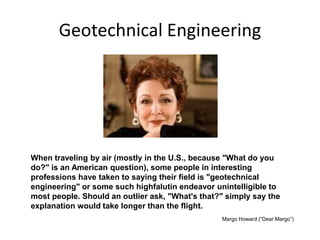Top Guidelines Of Geotheta
Top Guidelines Of Geotheta
Blog Article
What Does Geotheta Do?
Table of ContentsSome Known Details About Geotheta Some Known Details About Geotheta 6 Simple Techniques For GeothetaGeotheta - An OverviewUnknown Facts About Geotheta

They carry out website examinations, accumulate examples, carry out lab examinations, and examine data to evaluate the suitability of the ground for building and construction tasks - Engineer of Record. Based on their findings, geotechnical designers offer suggestions for structure layout, incline security, keeping structures, and mitigation of geotechnical dangers. They team up with various other specialists, such as engineers, architectural engineers, and building groups, to guarantee that geotechnical considerations are incorporated right into the total task layout and execution
By evaluating the behavior and properties of dirt and rock, they can recognize possible geotechnical threats such as landslides, dirt negotiation, or slope instability. Their experience helps avoid failings or crashes that could endanger lives and property. Below are some thorough obligations and responsibilities of a geotechnical designer: Site Investigation: Geotechnical designers conduct website examinations to gather information on subsurface conditions.
They translate the information to understand the properties and habits of the soil and rock, including their strength, permeability, compaction qualities, and groundwater problems. Geotechnical Evaluation and Style: Geotechnical engineers evaluate the data collected throughout website investigations to examine the security and suitability of the site for construction projects. They perform geotechnical estimations and modeling to review aspects such as bearing capability, settlement, incline security, lateral planet stress, and groundwater flow.
Indicators on Geotheta You Need To Know
Structure Style: Geotechnical engineers play a crucial role in making foundations that can safely support the desired framework. They evaluate the dirt conditions and tons needs to identify the appropriate structure kind, such as shallow structures (e.g., grounds), deep foundations (e.g (https://www.storeboard.com/geotheta)., piles), or specialized strategies like dirt renovation. They consider factors such as negotiation limits, birthing capability, and soil-structure communication to establish optimal structure designs
They assess building and construction plans, screen site activities, and carry out field assessments to verify that the style suggestions are followed. If unpredicted geotechnical problems arise, they analyze the situation and give suggestions for removal or adjustments to the style. Risk Assessment and Mitigation: Geotechnical engineers analyze geotechnical risks and threats associated with the task site, such as landslides, liquefaction, or dirt erosion.

Cooperation and Communication: Geotechnical designers work very closely with other experts involved in a job, such as architects, structural designers, and building groups. Reliable interaction and collaboration are vital to incorporate geotechnical considerations into the total project layout and building and construction process. Geotechnical engineers offer technological know-how, solution queries, and make sure that geotechnical needs are satisfied.
The 4-Minute Rule for Geotheta
Below are some sorts of geotechnical designers: Foundation Designer: Structure designers specialize in developing and analyzing foundations for structures. They analyze the dirt problems, lots needs, and site qualities to determine the most proper structure kind and layout, such as superficial structures, deep foundations, or specialized techniques like heap structures.
They assess the elements influencing slope stability, such as soil residential or commercial properties, groundwater conditions, and slope geometry, and develop methods to avoid slope failures and alleviate dangers. Quake Designer: Quake designers concentrate on evaluating and creating frameworks to stand up to seismic forces. They assess the seismic hazard of a website, assess soil liquefaction possibility, and develop seismic design standards to ensure the security and resilience of frameworks during earthquakes.
They execute area testing, accumulate examples, and analyze the gathered data to characterize the soil buildings, geologic developments, and groundwater conditions at a site. Geotechnical Instrumentation Designer: Geotechnical instrumentation designers concentrate on monitoring and measuring the actions of soil, rock, and frameworks. They install and keep instrumentation systems that keep track of aspects such as soil negotiation, groundwater levels, slope activities, and structural variations to assess efficiency and give very early cautions of possible issues.
The Single Strategy To Use For Geotheta
They perform tests such as triaxial examinations, consolidation tests, direct shear tests, and leaks in the structure tests to collect information for geotechnical evaluation and layout. Geosynthetics Designer: Geosynthetics designers concentrate on the design and application of geosynthetic products, such as geotextiles, geogrids, and geomembranes. They use these products to enhance soil security, reinforce inclines, supply drainage remedies, and control disintegration.
They tend to be investigative individuals, which means they're intellectual, introspective, and investigative. They are curious, methodical, logical, analytical, and sensible. Some of them are likewise social, indicating they're kind, generous, participating, client, caring, practical, compassionate, sensible, and pleasant - Tailings Engineer.
In the office environment, geotechnical engineers make use of specialized software application devices to execute computations, create styles, and assess data. They prepare reports, evaluation job requirements, communicate with customers and team members, and coordinate project activities. The office setup offers a favorable atmosphere for research, analysis, and partnership with other specialists associated with the task.
The smart Trick of Geotheta That Nobody is Discussing
They often see project websites to conduct website examinations, examine geotechnical site conditions, and collect data for evaluation. These sees entail taking a trip to different areas, often in remote or tough surfaces. Geotechnical engineers might do dirt sampling, conduct examinations, and monitor construction activities to make certain that the geotechnical aspects of the job are being applied correctly.
Geotechnical engineers likewise function in specialized geotechnical research laboratories. In these facilities, they conduct experiments, carry out examinations on dirt and rock examples, and analyze the engineering residential or commercial properties of the materials. Geotechnical lab engineers work extensively in these environments, handling screening tools, operating instruments, and recording data. They team up with other laboratory team to guarantee accurate and reliable screening results.
Report this page